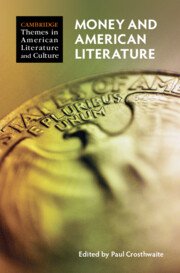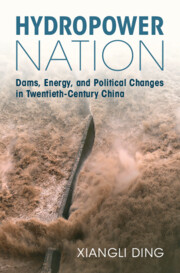Refine search
Actions for selected content:
138 results
Epilogue
-
- Book:
- The Nature of the Ottoman City
- Published online:
- 28 August 2025
- Print publication:
- 11 September 2025, pp 167-178
-
- Chapter
- Export citation
2 - Stephen Hero and A Portrait of the Artist as a Young Man
-
-
- Book:
- The Cambridge Companion to James Joyce
- Published online:
- 14 August 2025
- Print publication:
- 21 August 2025, pp 31-46
-
- Chapter
- Export citation
1 - The Force of Destiny
- from Part I - The Ascent
-
- Book:
- The Generalissimo
- Published online:
- 31 July 2025
- Print publication:
- 14 August 2025, pp 13-42
-
- Chapter
- Export citation

Money and American Literature
-
- Published online:
- 03 July 2025
- Print publication:
- 17 July 2025
Chapter 6 - How Hollywood Pictures Whiteness
- from Part I - Whiteness and National Identity
-
-
- Book:
- Whiteness and American Literature
- Published online:
- 19 June 2025
- Print publication:
- 03 July 2025, pp 89-102
-
- Chapter
- Export citation
Introduction
-
- Book:
- A History of East Asia
- Published online:
- 15 May 2025
- Print publication:
- 05 June 2025, pp 1-13
-
- Chapter
- Export citation
Chapter 6 - Gender, Space, and Feminist Geography
- from Part II - Developments
-
-
- Book:
- Space and Literary Studies
- Published online:
- 07 May 2025
- Print publication:
- 22 May 2025, pp 103-119
-
- Chapter
- Export citation
Chapter 8 - Empire, Nation, and the Question of Space
- from Part II - Developments
-
-
- Book:
- Space and Literary Studies
- Published online:
- 07 May 2025
- Print publication:
- 22 May 2025, pp 140-155
-
- Chapter
- Export citation
Chapter 16 - Political Poetics: Intercrossing Discourses and American Belonging
- from Part III - Genres
-
-
- Book:
- The Cambridge Companion to Nineteenth-Century American Literature and Politics
- Published online:
- 06 March 2025
- Print publication:
- 13 March 2025, pp 271-288
-
- Chapter
- Export citation
Afterword: Global Histories of Modern Europe
-
-
- Book:
- Globalizing Europe
- Published online:
- 06 March 2025
- Print publication:
- 13 March 2025, pp 271-278
-
- Chapter
- Export citation
Chapter 8 - Shakespeare’s Plants Then and Now
- from Part II - Anglophone Literary Forms
-
-
- Book:
- The Cambridge Handbook of Literature and Plants
- Published online:
- 06 February 2025
- Print publication:
- 13 February 2025, pp 149-165
-
- Chapter
- Export citation
Homeland Is Where the Soul Resides: Travel Prayer, Passports, and Nation in the Western Indian Ocean
-
- Journal:
- Comparative Studies in Society and History / Volume 67 / Issue 2 / April 2025
- Published online by Cambridge University Press:
- 13 February 2025, pp. 457-482
-
- Article
- Export citation
‘Brigantaggio’ revisited: historiographical experiences and prospects for research
-
- Journal:
- Modern Italy / Volume 30 / Issue 1 / February 2025
- Published online by Cambridge University Press:
- 20 January 2025, pp. 94-103
- Print publication:
- February 2025
-
- Article
-
- You have access
- Open access
- HTML
- Export citation
Chapter 14 - Naomi Mitchison
- from Part III - 1945–1975
-
-
- Book:
- The British Novel of Ideas
- Published online:
- 05 December 2024
- Print publication:
- 12 December 2024, pp 242-258
-
- Chapter
- Export citation
4 - The British People
-
- Book:
- Brexitspeak
- Published online:
- 22 November 2024
- Print publication:
- 05 December 2024, pp 85-102
-
- Chapter
- Export citation
African Studies Keyword: Science
-
- Journal:
- African Studies Review / Volume 67 / Issue 4 / December 2024
- Published online by Cambridge University Press:
- 25 November 2024, pp. 990-1010
-
- Article
-
- You have access
- Open access
- HTML
- Export citation
5 - Imported Labor
-
- Book:
- Refining the Common Good
- Published online:
- 08 November 2024
- Print publication:
- 21 November 2024, pp 88-111
-
- Chapter
- Export citation

Hydropower Nation
- Dams, Energy, and Political Changes in Twentieth-Century China
-
- Published online:
- 24 October 2024
- Print publication:
- 07 November 2024
Chapter 19 - The United Nations
- from Part 3 - The traditional agenda: States, wars and law
-
-
- Book:
- An Introduction to International Relations
- Published online:
- 31 August 2024
- Print publication:
- 12 August 2024, pp 258-269
-
- Chapter
- Export citation
Introduction
-
- Book:
- Disability, the Body, and Radical Intellectuals in the Literature of the Civil War and Reconstruction
- Published online:
- 13 June 2024
- Print publication:
- 04 July 2024, pp 1-30
-
- Chapter
- Export citation
